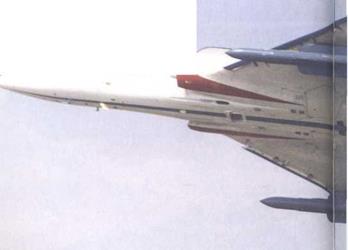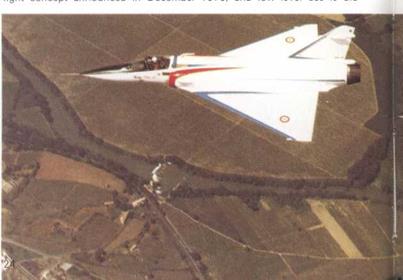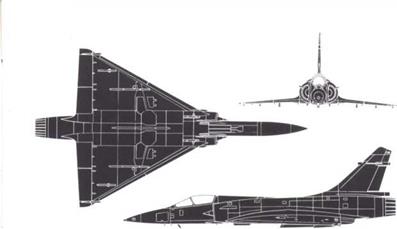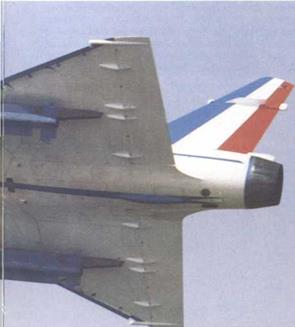Dassault Mirage 2000
Mirage 2000 (single – and two-seat versions)
Origin: Avions Marcel Dassault/Breguet Aviation. France.
Type: Multi-role fighter with emphasis on interception and air superiority combat.
Engine: One SNECMA M53-5 single-shaft afterburning by-pass turbojet (low-ratio turbofan) with maximum thrust of 12,3501b (5602kg) dry and 19.8401b (9000kg) with afterburner.
Dimensions: Span 29ft 6in (9 0m): length 50ft 3^in (15-33m).
Weights: Empty, not released: normal takeoff, air-intercept mission 33,0001b (14,969kg).
Performance: Maximum speed at 36,000ft (11,000m) Mach 2-3, 1,518mph (2440km/h).
Armament: Two 30mm DEFA 5-53 cannon: normal air-intercept load two Matra Super 530 and two Matra 550 Magic air-to-air missiles: intention is to develop ground-attack version with maximum overload of 1 1,0251b (5000kg) of weapons and/or tanks and ECM pods on five external hard – points.
History: Announcement of project December 1975: first flight 10 March 1978: production delivery, probably late 1982.
Users: Egypt (intended licence-production), France.
Development: In December 1975 the French government cancelled the Dassault-Breguet Super Mirage, which had been publicised as the Avion de Combat Futur and mainstay of the Armee de I’Air in the 1 980s. In its place it announced a decision to award a study contract with Marcel Dassault for a smaller and simpler single-engined delta fighter outwardly looking very much like the Mirage III of 20 years earlier. In fact the Mirage 2000 — some-

|
|
|

|
|
Above: Three-view of Dassault Mirage 2000.
times called the Delta 2000 – will differ significantly from the old Mirage, in aerodynamics, propulsion, structure and equipment. Aerodynamically it will be designed to incorporate American discoveries in CCV (control – configured vehicle) technology, in which aircraft are deliberately made unstable – for example, by positioning the centre of gravity much further back than usual – and using high-authority fail-safe flight-control systems to keep them under control. The result is either a smaller wing or, as in the Mirage 2000. dramatically higher manoeuvrability. Unlike the earlier Mirage deltas the 2000 will have leading-edge devices, either hinged droops or some form of slats, which will work in conjunction with the trailing-edge elevons to counteract the unstable pitching moment, or, in
Below: The second prototype Dassault Mirage 2000, with two Matra Super 530 air-to-air missiles (which are intended to be a standard weapon on aircraft of this type with the Armes de I’Air).
|
|
tight turn, relax their effort or even help the aircraft to pitch nose-up. In the landing configuration the leading-edge devices (the French call it a "variable-camber" wing) will allow the elevons to be deflected down, adding to lift, whereas in earlier tailless deltas they have to be deflected up, effectively adding to weight just at the worst time.
Already the Mirage 2000 is being publicised as "being able to outclass combat aircraft presently being developed and produced in the Western world". It will have: "fly-by-wire" multi-channel electrically signalled flight controls: composite materials, carbon fibre being mentioned: large – radius Karman fairings (a reference to area ruling of the fuselage for minimum transonic drag): an elaborate weapon system with "g. p." (general-purpose?) computer and inertial unit; and long-range digital radar. Ratio of thrust to weight is to exceed unity. Such features are what one would expect of such an aircraft, but the problems are clearly enormous, especially in a time of severe inflation and economic pressures. France has since 1975 made attempts to acquire the base of technology, especially in digital avionics, necessary to build the Mirage 2000, but has little capability as yet. Only a single French aircraft, a two-seat Mirage 111В with Sfena system, has flown with a primitive fly-by-wire system. Thomson-CSF estimate it will take "seven to eight years" to develop a 170-km-range digital radar needed to match the developed Super 530 missile. France has little experience of advanced composite structures, and that only in small test pieces and helicopters. SNECMA has not announced how the M53 engine, with very limited flight-time and no other application, is going to be increased in thrust by 35 per cent. If the aircraft to fly in 1 978 is truly a prototype, and not the first off a production line, it will need everything to go right to meet an in-service date of 1982 with a developed aircraft. Not least, the proposed price of Fr40 to 50 million (£4 5 to 5-5 million) will be extremely difficult to hold, even in December 1 975 Francs, because the magnitude of the system – development problems to France appear to have been grossly underestimated.
 |
In the original announcement the Mirage 2000 was described as "limited to high-speed and high-level interception and reconnaissance. . . . Attack and penetration at low levels will be undertaken by a different type." (The cancelled Super Mirage had been intended to fulfil all tactical roles.) But in December 1976 the Chief of Staff of the Armee de I’Air said he personally considered it would be necessary to build an interdictor and reconnaissance (he implied at low level) version of the Mirage 2000. It became known at this time that the new delta will apparently have nine weapon stations, which is diametrically opposed to the uncompromised high-altitude dog – finht concent announced in December 1975: and low-level use is dia-
metrically opposed to a large-area delta. The Armee de I ‘Air has from the start hoped to buy 200 Mirage 2000s, twice the number it judged it could afford of the Super Mirage. But future progress of the programme, helped by US industry strictly on an inter-company rather than a government basis, will be instructive to watch.












